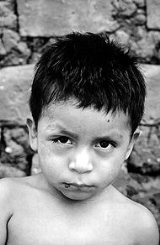
Romana's sign
Encyclopedia

Presentation
It occurs 1-2 weeks after infection. It is due to conjunctival swelling after contamination with the vector's fecesFeces
Feces, faeces, or fæces is a waste product from an animal's digestive tract expelled through the anus or cloaca during defecation.-Etymology:...
, which contains the parasitic Trypanosoma cruzi
Trypanosoma cruzi
Trypanosoma cruzi is a species of parasitic euglenoid trypanosomes. This species causes the trypanosomiasis diseases in humans and animals in America...
. Although very characteristic of Chagas' disease, not all patients with the acute form develop Romaña's sign.
When one has Romaña's sign, one will have subcutaneous inflammatory nodule or nonpurulent unilateral palpebral edema
Edema
Edema or oedema ; both words from the Greek , oídēma "swelling"), formerly known as dropsy or hydropsy, is an abnormal accumulation of fluid beneath the skin or in one or more cavities of the body that produces swelling...
and conjunctivitis
Conjunctivitis
Conjunctivitis refers to inflammation of the conjunctiva...
with ipsilateral regional lymphadenopathy
Lymphadenopathy
Lymphadenopathy is a term meaning "disease of the lymph nodes." It is, however, almost synonymously used with "swollen/enlarged lymph nodes". It could be due to infection, auto-immune disease, or malignancy....
.
Eponym
It is named after Cecilio RomañaCecilio Romaña
Cecilio Felix Romaña was an Argentinian physician remembered for describing Romaña's sign. He researched tropical diseases from 1930 to 1960 in Northern Argentina, particularly Chagas disease. His description of his eponymous sign in 1935 allowed for earlier and easier diagnosis of this disease in...
, an Argentinian researcher who first described the phenomenon.

